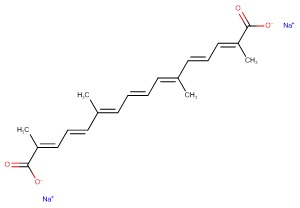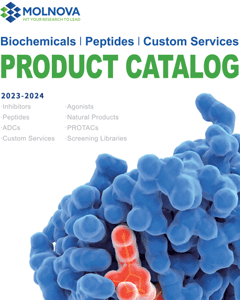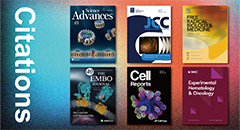
Transcrocetinate disodium
CAS No. 591230-99-8
Transcrocetinate disodium( Disodium trans-crocetinate )
Catalog No. M21664 CAS No. 591230-99-8
Transcrocetinate disodium extracted from saffron (Crocus sativus L.) is a high-affinity antagonist of NMDA receptor.
Purity : >98% (HPLC)
 COA
COA
 Datasheet
Datasheet
 HNMR
HNMR
 HPLC
HPLC
 MSDS
MSDS
 Handing Instructions
Handing Instructions
| Size | Price / USD | Stock | Quantity |
| 5MG | 80 | Get Quote |


|
| 10MG | 110 | Get Quote |


|
| 25MG | 196 | Get Quote |


|
| 50MG | 287 | Get Quote |


|
| 100MG | 429 | Get Quote |


|
| 200MG | Get Quote | Get Quote |


|
| 500MG | Get Quote | Get Quote |


|
| 1G | Get Quote | Get Quote |


|
Biological Information
-
Product NameTranscrocetinate disodium
-
NoteResearch use only, not for human use.
-
Brief DescriptionTranscrocetinate disodium extracted from saffron (Crocus sativus L.) is a high-affinity antagonist of NMDA receptor.
-
DescriptionTranscrocetinate disodium extracted from saffron (Crocus sativus L.) is a high-affinity antagonist of NMDA receptor.(In Vitro):Crocetin (Transcrocetin, trans-Crocetin) disodium, a saffron metabolite originating from the crocin apocarotenoids, has been shown to exert strong NMDA receptor affinity and is thought to be responsible for the CNS activity of saffron.To ensure unchanged viability of Caco-2 cells throughout the transport experiments, cellular mitochondrial dehydrogenase activity of Caco-2 cells is measured by MTT assay after a 24 h incubation period with the test compounds.
-
In VitroCrocetin (Transcrocetin, trans-Crocetin) disodium, a saffron metabolite originating from the crocin apocarotenoids, has been shown to exert strong NMDA receptor affinity and is thought to be responsible for the CNS activity of saffron.To ensure unchanged viability of Caco-2 cells throughout the transport experiments, cellular mitochondrial dehydrogenase activity of Caco-2 cells is measured by MTT assay after a 24 h incubation period with the test compounds: Hydroalcoholic saffron extract saffron extract (SE, 0.5-1 mg/mL) and crocin-1 (250-1000 μM) reveal no negative significant changes in cellular viability. Crocetin disodium at 10 μM level does not change viability while higher concentrations (40-160 μM) reduces significantly cellular viability.
-
In Vivo——
-
SynonymsDisodium trans-crocetinate
-
PathwayMembrane Transporter/Ion Channel
-
TargetNMDAR
-
RecptorNMDA receptor
-
Research Area——
-
Indication——
Chemical Information
-
CAS Number591230-99-8
-
Formula Weight372.37
-
Molecular FormulaC20H22Na2O4
-
Purity>98% (HPLC)
-
SolubilityDMSO:Soluble
-
SMILESO=C([O-])/C(C)=C/C=C/C(C)=C/C=C/C=C(C)/C=C/C=C(C)/C([O-])=O.[Na+].[Na+]
-
Chemical Name——
Shipping & Storage Information
-
Storage(-20℃)
-
ShippingWith Ice Pack
-
Stability≥ 2 years
Reference
1.Lautenschl?ger M et al. Intestinal formation of trans-Crocetin from saffron extract (Crocus sativus L.) and in vitro permeation through intestinal and blood brain barrier. Phytomedicine. 2015 Jan 15;22(1):36-44.
molnova catalog



related products
-
Cycloleucine
Cycloleucine is an antagonist of NMDA receptor associated glycine receptor with a Ki of 600 μM. Cycloleucine is also a competitive inhibitor of S-adenosyl-methionine mediated methylation with anxiolytic and cytostatic effects.
-
CIQ
CIQ is a subunit-selective potentiator of NMDA receptors containing the NR2C or NR2D subunit. EC50 value: 2.7 μM for NR2C and 2.8 μM for NR2D.
-
Riluzole
Riluzole is a sodium channel protein inhibitor and potent neuroprotective agent.



 Cart
Cart
 sales@molnova.com
sales@molnova.com


